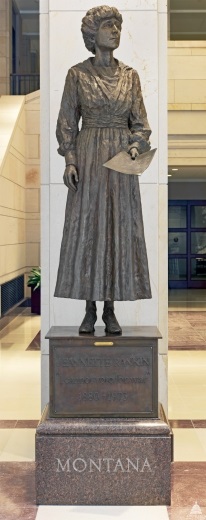Published: March 4, 2017
This year marks the 100th anniversary of Jeannette Rankin becoming the first woman to serve as a Member of Congress. She was elected in November 1916, by the state of Montana, to the U.S. House of Representatives, and began her term March 4, 1917. She was elected four years before women had the right to vote nationally and blazed a trail followed by more than 300 women who have served as a U.S. Representatives, Delegates, or Senators.
“I may be the first woman member of Congress,” she observed upon her election in 1916. “But I won’t be the last.”
Jeannette Rankin learned how to work hard early in life, with her mother as a teacher and her father as a rancher. She attended Montana State University, New York School of Philanthropy, and the University of Washington and tried several occupations before going into the political arena and realizing her passion for the women’s suffrage movement.
As the first woman member in Congress, Rankin stood on the front lines to bring attention to the national suffrage fight. She advocated the creation of a Committee on Woman Suffrage.

During her two-year term in the House she voted against President Woodrow Wilson’s declaration of war on Germany, created legislation for women’s rights and helped pass the Nineteenth Amendment granting women the right to vote.
Later, at close to 60 years of age, she began a second term in the House representing Montana’s first district. She was the only Member of Congress to vote against America’s involvement in WWII, and after receiving much criticism she did not run for re-election in 1942, ending her political career.
Her 90th birthday in 1970 was celebrated in the Rayburn House Office Building with a reception and dinner. At the time of her death, on May 18, 1973, in Carmel, California, Rankin was considering another run for a House seat to protest the Vietnam War.
Upon her death, Rankin left a portion of her Georgia estate to assist unemployed women workers. Her personal assistant along with friends established a foundation, chartered in 1976, which has been providing scholarships to low-income women, aged 30 and over, helping them succeed through education.
In 1985, a bronze statue of Jeannette Rankin was given to the National Statuary Hall Collection by Montana and stands in Emancipation Hall of the U.S Capitol Visitor’s Center.
Related Legislation
159 Cong. Rec. H938 - Commemorating the Legacy of Jeannette Rankin
PDF
Details
99 Stat. 1932 - Jeannette Rankin--Statue Placement in Capitol Rotunda
PDF
Details
S. Doc. 112-9 - Nineteenth Amendment - Women's Suffrage Rights
PDF
Details
H. Doc. 108-223 - Women in Congress 1917 - 2006
PDF
Details
Additional Resources & Sources
View historic video footage and memories of Jeannette Rankin on the U.S. House of Representatives’ History, Art & Archives webpage.
Visit the U.S. Government Publishing Office Bookstore’s website to purchase “Women in Congress, 1917 – 2006.” It provides information on women in Congress, from Jeannette Rankin to the members of the 109th Congress.
The United States Senate, Senate History
The United States House of Representatives, History, Art & Archives
Biographical Directory of the United States Congress
United States Capitol, Architect of the Capitol
Library of Congress, Prints & Photographs Online Catalog